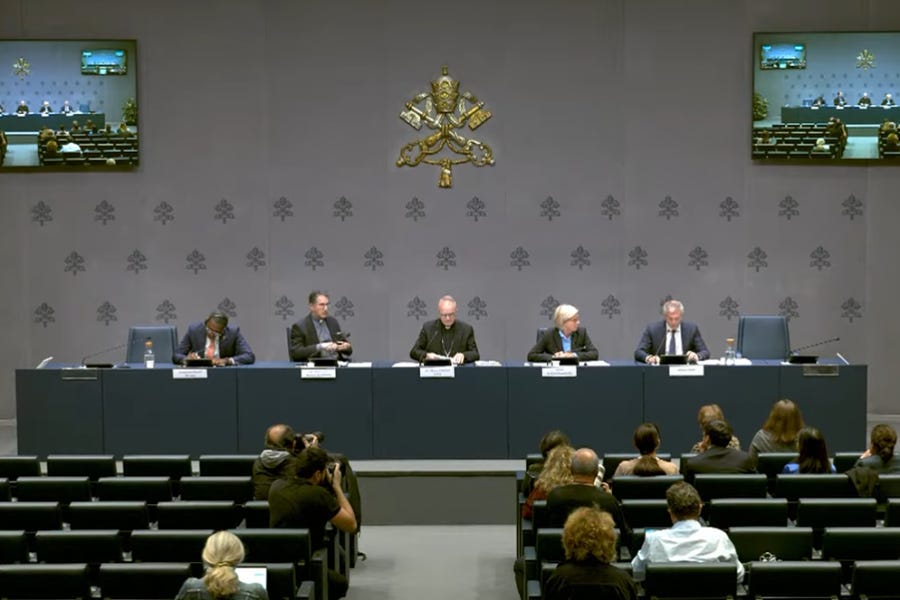What’s in the Vatican’s 2nd global child protection report?
Description
The Pontifical Commission for the Protection of Minors released its second annual global child protection report Thursday, underlining the need for reparations, sanctions for abusers, and clear communication when bishops resign after mishandling cases.

The 200-page “Annual Report on Church Policies and Procedures for Safeguarding” was released Oct. 16 in five languages and with a Vatican press conference attended by the PCPM’s new president, the French Archbishop Thibault Verny, who succeeded founding president Cardinal Seán O’Malley in July.
PCPM members believe the publication of the first annual report marked a breakthrough in the worldwide struggle against abuse in the Catholic Church. The second report is twice the length but has the same structure as the pilot study, with four sections, focusing respectively on local Churches, continental blocs, the Roman curia, and the Church’s wider child protection efforts. A 13-page executive summary accompanies the full text.
Like its predecessor, the new report employs diplomatic language. But it arguably offers an even sharper critique of the state of safeguarding in the Church today.
Here’s a quick overview of what the document says, and what it means.
Comprehensive reparations
What it says
The new report, which covers the 2024 reporting period, focuses on the theme of reparations, one of “pillars” of the PCPM’s work, alongside truth, justice, and institutional reform. The text calls for a comprehensive approach to reparations that goes beyond financial compensation to include the creation of listening centers for victims, the provision of professional psychological support, public acknowledgement of errors combined with apologies, and invitations to survivors to help develop safeguarding policies.
What’s the context?
The quality of the reparation offered to victims varies considerably around the world, from often impoverished countries where the Church offers little or nothing, to others, such as Germany, that have fine-tuned policies and procedures.
Tangible sanctions
What it says
The report presents “an operational vademecum” to help local Churches offer reparation to victims. The vademecum, or guide, highlights the need for “meaningful sanctions for perpetrators and enablers of abuse.”
What’s the context?
The report suggests that the Church often leaves victims uncertain about whether their abusers and those who covered up for them have been held to account. It argues that true reparation can only be made when there are tangible disciplinary actions against the perpetrators and their enablers.
Clarity on episcopal resignations
What it says
The new report drives home a call in the first report for a “streamlined procedure” for removing bishops who mishandle abuse cases.
It “underlines the importance of clearly communicating the reasons for resignation or removal, and issuing a public statement when these reasons are related to the abuse of minors or vulnerable adults, negligence, or less serious actions that nonetheless may have led to such a decision.”
What’s the context?
The Vatican used to announce a bishop’s early departure with reference to the relevant part of the Code of Canon Law under which their resignation was accepted. It would say, for example, that a bishop resigned in accordance with Canon 401 §2 of the Code of Canon Law, which says that “a diocesan bishop who has become less able to fulfill his office because of ill health or some other grave cause is earnestly requested to present his resignation from office.” That practice stopped roughly 10 years ago.
This change was brought up at the press conference launching the new report. PCPM secretary Bishop Luis Manuel Alí Herrera said the issue had been raised with Pope Leo XIV, who was “very interested” in commissioning research on the matter.
Scrutinizing Italy
What it says
The report offers a candid assessment of the quality of safeguarding in the Catholic Church in Italy. It laments that not all dioceses and regional groupings cooperated with the PCPM’s researchers. It presents 15 recommendations that suggest the local Church has considerable ground to make up in the fight against abuse.
What’s the context?
Critics have accused the Italian bishops of lagging behind other European Church leaders in shedding light on abuse cases and developing national safeguarding policies. The Italian Church has developed a strategic plan for combating abuse in the five years ending in 2029, but the PCPM notes this hasn’t been published on the national website.
Other countries
What it says
The report also presents analyses of individual countries in Asia (Japan and South Korea), Africa (Equatorial Guinea, Ethiopia, Gabon, Guinea, Kenya, Mali, Mozambique, Lesotho, Namibia, and the Regional Episcopal Conference of North Africa), and Europe (Bosnia-Herzegovina, Greece, Malta, Portugal, and Slovakia).
What’s the context?
Some countries, such as Gabon, are in the early stages of establishing safeguarding mechanisms, while others, like Slovakia, are further advanced. By offering an analysis of each nation alongside recommendations for improvement, the report is setting down benchmarks by which future progress can be judged.
Assessing the Dicastery for Evangelization
What it says
The Dicastery for Evangelization, which oversees more than 1,000 ecclesiastical circumscriptions around the world, has “addressed two cases of negligence involving bishops, under the provisions of Vos estis lux mundi,” according to the report.
Vos estis lux mundi is a 2019 papal document setting out norms for holding bishops responsible for mishandling abuse cases.
What’s the context?
The low figure was described as a “shocking revelation” by the AP’s Nicole Winfield, who <a href="https://www.youtube.com/live/-VxNpIgK9Nk?si=Ss97_qRJUUTT43Je&t=2





